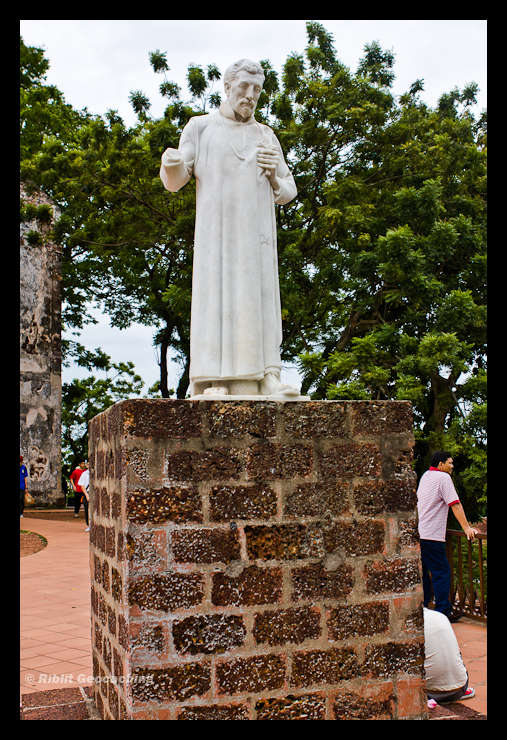St Francis Xavier
This statue, in front of the ruins of St Paul's church, was conpleted in 1952. The right arm was broken when the branch of a casurina tree fell on it the day after the statue was consecrated.

St Francis Xavier is the patron saint of Catholic Missionaries in foreign lands.
Francis Xavier was born on April 7th 1506 in what is now Northern Spain. Spanish custom of the time was to give the surname of both the father and the mother so his name is accurately written Francisco de Xavier (Latin Xaverius) rather than Francisco Xavier, as Xavier is originally a place name. He received his early education at Xavier then, at 19, studied at the University of Paris, where he received a licence ès arts in 1530.
While at the university he met Ingnatius Loyola and together with five others they founded the Society of Jesus and made a vow of poverty, chastity and obedience. He travelled to Venice, Italy with the members of the new order and was ordained a priest in June 1537.
Francis travelled alone to Goa which was, in 1540, the centre of Portuguese activity in the East, where he spent the next 3 years among the Paravas, the pearl fisherman of the southeastern coast. Here he translated a small catechism into native Tamil and went from village to village instructing and confirming new converts.
Shortly afterward, the primitive Macuans on the southwestern coast requested baptism, and, after brief instructions, Francis baptized ten thousand of them in the last months of 1544. He organized schools to help maintain their new faith.
He travelled to Malacca in 1545 and spent several months among the population there before founding missions among the Malays.
Five years after Japan had been first visited by Europeans he travelled there with Anjiro, a japanese he had met earlier in Malacca. He discovered that his lifestyle of poverty, which had so inspired the Paravas and Malays, often repelled the Japanese, so he replaced it with one of studied display and dignity. He also came to realise that he would have to convert China in order to convert Japan and travelled to the island of Sancian (now Shang-ch'uan Tao, off the Chinese coast) to attempt to secure entrance to the country which was then closed to foreigners.
He met his death on Shangchuan Island where he fainted after celebrating mass and died of fever on December 3rd 1552, two weeks later.
He died in a wooden hut built for him by his ship crew. His companion present at his final moments was a Chinese convert Anthony who had accompanied him from Goa. Anthony organized a simple burial on Sancian and had the coffin filled with lime "to consume the flesh and leave only the bare bones in case anyone should come later on and take the body back to India". His ship, the "Santa Cruz " remained on Sancian till February of the following year. While the ship was just about to leave Sancian, Anthony reportedly asked the ship's Captain if the body of Xavier should be inspected to see if it had already decayed as it was over three months since his burial. A seaman then was then sent to check and he found the body intact. It had not decayed at all.
Thus began the saga of the "incorruptibility of his body". It was then decided to take the body back to Malacca. The Ship arrived at Malacca on March 22 1553. The body was buried at Malacca in a rock cut grave and filled with earth. Five months later it is said that a dear friend of Xavier wished to see his body one last time and then reportedly dug out his body in the middle of the night. he too found the body again intact. Deciding that it was a miracle, he secretly hid it in a coffin. This news of the "Incorrupt body of Francis Xavier" finally reached the Viceroy of Goa and he ordered its return to Goa.
Francis was beatified by Paul V on October 25, 1619, and was canonized by Gregory XV on March 12, 1622, at the same time as Ignatius Loyola. He is the patron saint of Navarre, Spain; Nasugbu, Batangas, Philippines; Australia; Borneo; China; the East Indies; Goa, India; Japan; New Zealand, and of missionaries. His feast day is December 3. In 1927 he was named patron of all missions.
references:
Patron Saints Index: Saint Francis Xavier – Catholic Forum